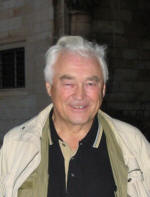Ten years ago, at SoftCOM 1999, we gave a seminar lecture on the evolution of software architecture. It seems appropriate to revisit the topic and focus on some recent futuristic developments in this field. Two major directions stand out pursued by several organizations: Pervasive Computing and Human-Centric Computing. One includes IBM’s Project Blue and Carnegie Mellon’s project Aura, as prominent representatives of “Pervasive Computing”. The other is Project Oxygen under the leadership of MIT with cooperation by several companies (Acer, HP, Nokia, Philips) pursuing the concept of “Human-Centric Computing”. The Microsoft Hailstorm project can be considered an early manifestation of pervasive computing. Pervasive systems focus on devices which are portable and constantly connected. Human-Centric systems focus on the solution of human needs with natural interfaces like speech and gestures. As software architects we look at each system from two complementary aspects: the user’s point of view, the exo-architecture, and the builder’s point of view, the endo-architecture that deals with structural components and their interactions. In this seminar we are going to briefly review the evolution of software architecture from its beginnings to the present culmination as evident in these new developments.
 |
Dr. Gottfried W. R. Luderer was appointed Professor, ISS Chair of Telecommunication, at Arizona State University in the Fall of 1990. His current research program in networking includes work in the areas of control of ISDN/Broadband ISDN networks, mobile communication networks, and multimedia communication, which ranges from call processing for intelligent network services to network management. Research emphasis is on advanced software technologies for development of telecommunication networks, as used in switches, for signaling and in network management, with a focus on object and component technology and formal definition techniques. From 1965 to 1989, Dr. Luderer was with |
| AT&T Bell Labs, at last directing research on next generation switch architectures, based on fast packet switching technology on the hardware side and object-oriented design technology on the software side, resulting in some of the earliest demonstration networks for multimedia communication. Dr. Luderer holds Diplomingenieur (M.S) and Dr.-Ing. (Ph.D) degrees in Electrical Engineering from the Technical University of Braunschweig, Germany. He holds two patents. While at Bell Labs, he taught at Stevens Institute of Technology in Hoboken, NJ, and at Princeton University. He is member of ACM, IEEE, IEEE Computer and Communication Societies. | |
Tomography is the study of the reconstruction of twoand three-dimensional objects from one-dimensional slices. Computed tomography is the technique of estimating the interior of objects from measurements through the object, wellknown from medical applications where usually X-rays are used. In the case of magnetic field tomography (MFT) the ionizing radiation is relieved by harmless magnetic field measurements. The paper reviews the MFT techniques and describes their biomedical applications. Finally, the use of MFT for solving inverse field problems in biomagnetism (Magnetic Source Imaging, MSI) as well as the verification of numerical simulations by means of physical phantoms will be shown in detail.
The presence of non-ionizing electromagnetic radiation in the environment has been associated with the controversy on the possible adverse health effects. Generally, the effects of electromagnetic fields on humans depend on their intensity and frequency.Thus, the fields are split into two main categories: low frequency spectrum (up to about 30kHz) and high frequency spectrum (from 30kHz to 300GHz). The objective of the tutorial is to provide fundamental information regarding the human interaction with electromagnetic radiation and to cover several aspects of electromagnetic and thermal dosimetry, biological effects, measurement techniques and exposure limits regarding the possible radiation hazard with reference to the existing International Commission on Non-Ionizing Radiation Protection (ICNIRP) Guidelines for human beings exposure limits. The tutorial starts with some general aspects of electromagnetic fields coupling to the human body and related possible health risk. The introductory part will also provide a quick course in fundamentals of electromagnetic theory. The participants will be then introduced to the known coupling mechanisms between electromagnetic fields and the human body. Relevant safety standards and limiting exposures to electromagnetic radiation, established by he international guidelines and some protective measures will be discussed, as well. This will be followed by certain calculation and measuring techniques for the analysis of electromagnetic field sources from extremely low frequency (ELF) to high frequency (HF) range. The central part of the tutorial deals with the essentials of the mathematical modeling of humans exposed to electromagnetic fields using both simplified cylindrical antenna and realistic anatomically based representation of the human body and the related boundary element (BE) solution procedures of the governing equations. The tutorial ends up with human body thermal response due to an absorbed electromagnetic energy from external sources. Some details regarding the numerical treatment of a stationary and transient bio-heat transfer equations via finite element method (FEM) will be given.
 |
Dr. Dragan Poljak was born in Split, Croatia in 1965. He received his BSc in 1990, his MSc in 1994 and PhD in electrical engineering in 1996 from the University of Split, Croatia. He is the Full Professor at the Department of Electronics at the University of Split, and he is also Adjunct Professor at Wessex Institute of Technology. His research interests include frequency and time domain computational methods in electromagnetics, particularly in the numerical modeling of wire antenna structures, and recently numerical modeling applied to environmental aspects of electromagnetic fields. To date Professor Poljak has publishednearly 200 journal and conference papers in the area of computational |
| electromagnetics, seven authored books and one edited book, by WIT Press, Southampton-Boston., and one book by Wiley, New Jersey. Professor Poljak is a member of IEEE, a member of the Editorial Board of the journal Engineering Analysis with Boundary Elements, and co-chairman of the WIT International Conference on Computational Methods in Electrical Engineering and Electromagnetics. He is also editor of the WIT Press Series Advances in Electrical Engineering and Electromagnetics. Recently, professor Poljak was awarded by the National Prize for Science. | |
